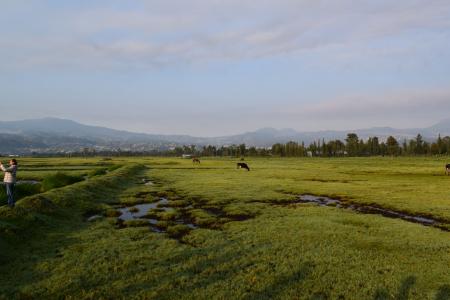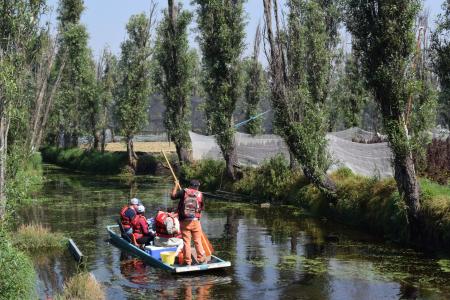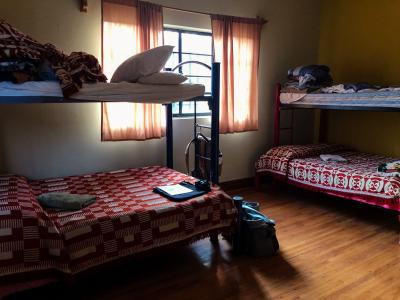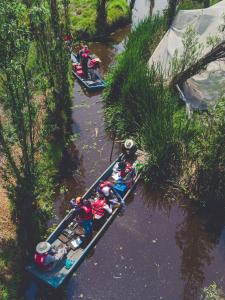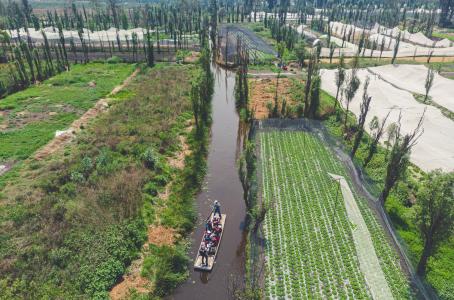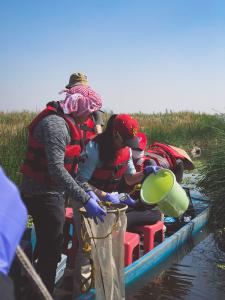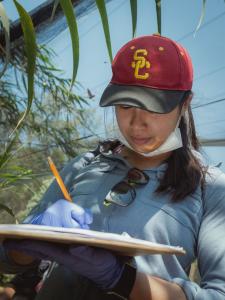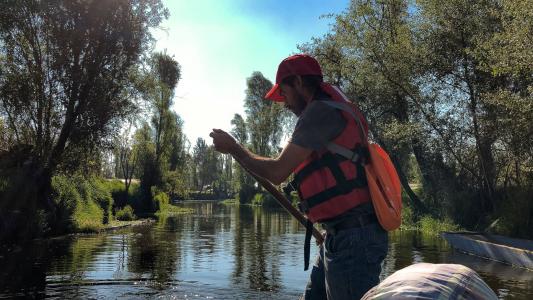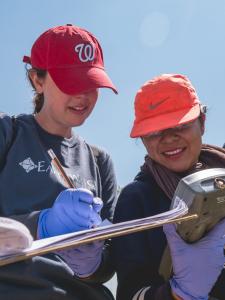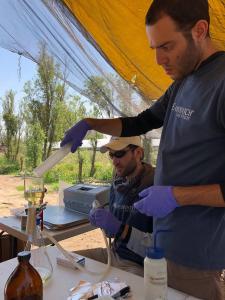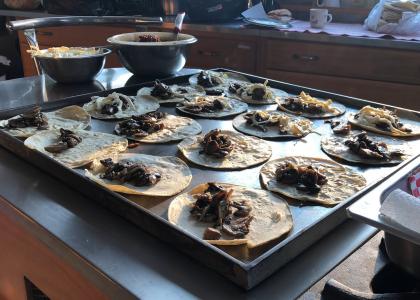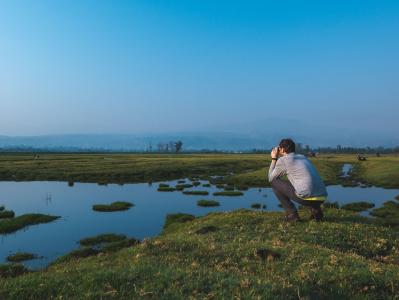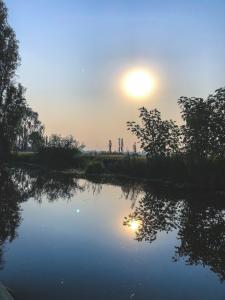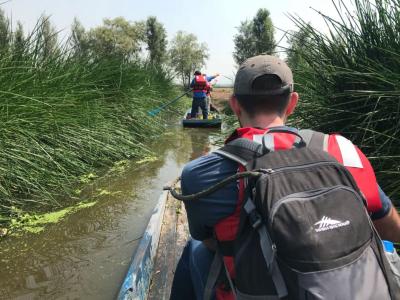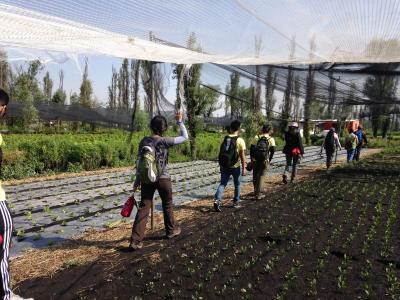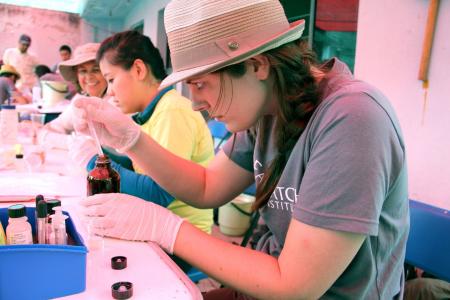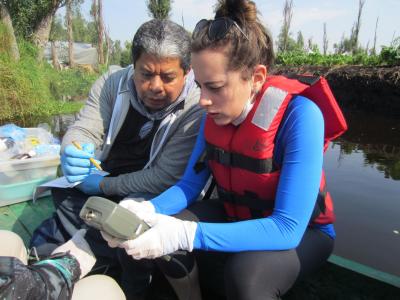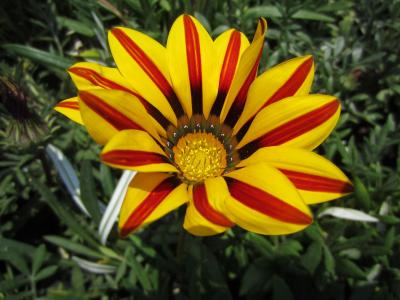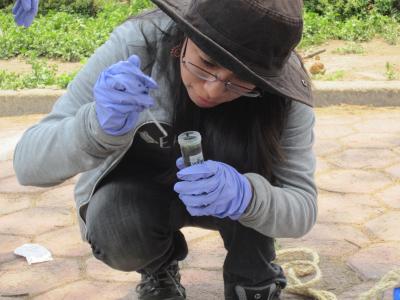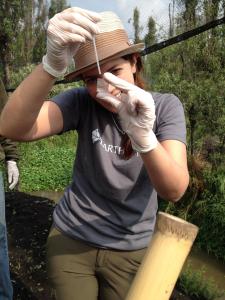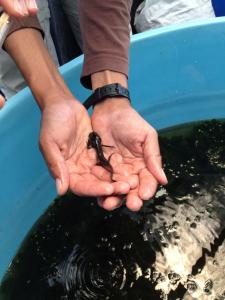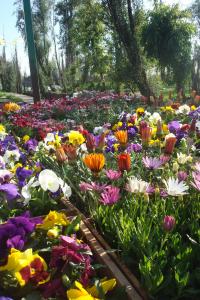The Research
Conservation of native plants and animals in Xochimilco is strongly linked to the preservation of its wetlands and chinampas—dry land within the wetlands that supports a traditional form of agriculture that has been carried out in the region for at least six centuries. This heterogeneous water system forms a unique ecological niche for aquatic species, including endemic (native) species such as the Mexican axolotl salamander (Ambystoma mexicanum) and the acocil crayfish (Cambarellus montezumae), as well as over 140 species of migrating birds. During the last few decades, however, traditional chinampas in the Xochimilco wetlands have faced major changes in water and soil quality due to more intensive farming methods, urban development, and exotic species introduction.
San Gregorio Atlapulco is a small town with the oldest human settlements in the area. Most of the springs providing water to the wetland originate at canals of San Gregorio; hence San Gregorio´s inhabitants have suffered the most due to the impact of water extraction from aquifers in order to provide fresh water to the Mexico City megalopolis. A consequence from the ground water extraction is the subsidence of the chinampas, which is visibly evident in different plots of San Gregorio. Water dynamics have also changed leaving the chinampas next to urban areas without nearby water (GPP, 2012). In the absence of action from the government, farmers are filling canals and ditches to bring water closer to expand the cultivation area and reduce labor, further changing surface hydrology of the wetlands. Similarly, urbanization and poor municipal planning, including canal dredging, and waste water discharge from urban areas, have drastically decreased the water quality in the wetlands, increasing the presence of E.coli and viruses. In fact, almost all of the water that now resides in the Xochimilco-San Gregorio canals has been pumped in from the city water treatment plants in Mexico City, leading to high concentrations of nutrients and a constant input of heavy metals. Finally, introduced exotic species have altered the natural food chain. For example, introduced bottom-dwelling fish such as carp (Cyprinus carpio) and tilapia (Oreochromis niloticus) feed on organisms that live on canal bottoms. For years, these organisms have acted as predators for both the axolotl and the acocil, so the increased competition from the carp and tilapia have caused axolotl and acocil populations to drastically decline.
Nevertheless, the Xochimilco wetlands still provide ecosystem services to the surrounding towns as well as Mexico City, including water filtration for underground aquifers, weather regulation, storm protection, air cleaning, and support for native species of flora and fauna. Researchers on Conserving Wetlands and Traditional Agriculture in Mexico are looking to ascertain how land use, agricultural techniques, and seasonality affect the microhabitat conditions around the chinampas. Specifically, researchers (and you while on your expedition!) are collecting data on the presence of endemic species and water quality around the chinampas. This data will be used to increase local awareness of the benefits of traditional agriculture and subsequently, improve ecosystem health.
Research Aims
The wetlands of Xochimilco are strongly representative of developing urban areas worldwide, which suffer from water shortages and diminishing water quality, stemming from poor municipal planning and urbanization. To improve human health in these regions, it is important to provide adequate water supplies. In partnership with Restauración Ecológica y Desarrollo, A.C. (REDES), a local nonprofit organization, researchers are working to better understand the impact of land use on local water quality and on the abundance of native salamander, the axolotl.
A variety of parameters can be measured when improving water quality; however, sometimes it is difficult to associate these parameters with the expected benefits of the restored water. Also, the comparison of measured variables in the water with acceptable values may not depict the whole picture and can lead to false assumptions of the water quality. One approach to assess and understand the general water quality status of a body of water is a water quality index (WQI). WQI transforms a complex group of data taken in the field and by laboratory analysis and assigns a single value to the quality of a body of water, which can help provide an understanding of the fitness of the water for different purposes. In the same way, other ecological indices such as species richness, evenness, diversity, etc., can be used to asses a body of water.
For instance, the vegetated area located between agricultural land and a body of water is called a buffer zone, and it helps to avoid water quality degradation by preventing the influx of high concentrations of nutrients, pesticides, or sediment. Buffer zones also provide bank stabilization, floodwater detention, and wildlife habitat. Therefore, by including the condition of the riparian vegetation, a much better evaluation of the ecological condition of the body of water can be obtained. Additionally, an index assessing the living organisms, such as zooplankton and phytoplankton, in the water can also provide information on the water quality. Nevertheless, no quality index can provide a complete assessment of a body of water.
Therefore, the objective of our study is an effort to have more holistic approach to understand and propose solutions to the problems of the area, including the reintroduction of the axolotl. As for the agriculture in the area, the traditional technique uses sediment as substrate to grow the seeds, and then they transplant them to the crop area. Therefore, evaluation of heavy metals and other pollutants in sediment and water is important for ensuring food security.
Education is another very important aspect for tackling the problems in the area. Working with farmers about these issues and on the importance of changing agriculture techniques will create more sustainable practices to preserve soil, water, and biodiversity in this unique ecosystem. The San Gregorio wetlands, in spite of the magnitude of anthropogenic impacts, is an important area that provides essential ecosystem services, such as water, oxygen, biodiversity, and food.
Using the past two years of research on water quality and riparian vegetation indices, Dr. Claudia Ponce De León and Dr. Diego Chaparro, who are researchers from the National Autonomous University of Mexico (UNAM), along with Ms. Elsa Valiente and the REDES team, aim to identify which canals are best suited for the needs of Axolotls to recover their population and thrive. Once the canals are identified, native aquatic plants will be reintroduced in order to achieve the following objectives in the next two years: nutrients removal, increasing dissolved oxygen concentrations, and decrement of suspended solids. Once habitat conditions are suitable, then a few axolotl individuals will be introduced in cages in order to monitor their development and breeding.
How You Will Help
As an Earthwatch volunteer, you will be involved in all areas of research to help achieve the scientific objectives. Specifically, you will:
- Collect water quality data: Walking or using small canoes or “canoas” you will be visiting various sites to sample canal water. With each sample you will test for the presence of heavy metals, bacteria, and nutrients.
- Study local agriculture practices and collect soil samples: By visiting local farms you will be exposed to a variety of techniques, which have different impacts on crops and the environment. You will also be collecting sediment samples to be analyzed in the laboratory later for heavy metals and other pollutants.
- Sample for endemic species: The axolotl is an endemic salamander to Xochimilco that is in danger of extinction. You will help scientists sample new areas where the salamander may be present and will collect its main food, zooplankton.
- Habilitation of artificial wetlands: Using local and not invasive material, you will construct and place artificial wetlands in the experimental canals.
- Monitor the biological, physico-chemical characteristics of water which influence axolotl growth and breeding.
- Assess the riparian vegetation in detail in order to understand its function in the water quality of the canals by retaining nutrients and other pollutants.
Life in the Field
Upon arrival, you’ll receive a safety briefing and a welcome presentation on local history, conservation priorities for Xochimilco wetlands, local examples of global issues, and a framework for all the project’s key objectives. Research scientists will offer a visit to the specialized laboratory where your samples will be analyzed. When we begin our fieldwork, project staff will introduce and demonstrate each new task; we’ll work with you until you’re comfortable with any new activities. We will also supervise to ensure data quality.
On the last day, we will lead you in a discussion of possible solutions to conservation issues.
DAILY ACTIVITIES
All days will start with a group breakfast at Casa Xitla. Afterwards, we will have a morning briefing to outline the general schedule for the day. This briefing will give everyone a clear idea of what the day will bring, what supplies you will need and when we anticipate returning to the accommodations. Then we will get into the project vehicles and head to the field site. Due to frequently heavy traffic in Mexico City, please note that the drive may take around an hour on some days.
The morning hours will be dedicated to fieldwork including water quality sampling, sediment sampling, and biodiversity sampling. This could be either while traveling on canoas or sampling directly from farms on land. Around 1:00 or 2:00 p.m., we will enjoy a delicious home cooked lunch made by our team chefs and a short break out in the field. Afternoons will vary according to weather conditions and research needs. Some days we will tackle more field work while other days we will focus more so on data entry and analysis. After a long day of fieldwork and data collection, we will return to Casa Xitla for showers and relaxation. Then, we will convene for a group dinner and evening wrap up of the day’s events. Guest lectures and supplemental presentations on axolotl research, water quality in Mexico City, etc. may also occur in the evenings.
Weather and research needs can lead to changes in the daily schedule. We appreciate your cooperation and understanding.
DAILY ACTIVITIES
- Day 1: Rendezvous, introductions, travel to Casa Xitla
- Days 2–6: Fieldwork days
- Water quality, soil and biodiversity sampling
- Visiting local farms to understand the variety of land and water management techniques
- Analyzing water for heavy metals, bacteria and nutrients
- Day 6: Research wrap-up and recreation time in Mexico City
- Day 7: Team departs
Accommodations and Food
* Please note that not every expedition has couples’ or single's accommodations available. Please call or email Earthwatch to check for availability prior to reserving your space(s) on the team.
For the full duration of the expedition, you will stay at the eco-friendly Casa Xitla, a property managed by a local non-profit called Lekil Kuxlejal. The house is located in Tlalpan, one of the 16 administrative boroughs in Mexico City and is well known for having over 80% of its land set aside for conservation purposes.
SLEEPING
Casa Xitla has two separate buildings that can accommodate three to four large groups at a time. You will likely encounter other groups besides Earthwatch during your stay at Casa Xitla. Your team will stay in a private building with four large bedrooms (with five beds in each) throughout which your team can spread out. Private rooms might be possible depending on team size. There are also two smaller bedrooms that will be occupied by your field team leaders. The house will provide bedding, pillows, and towels.
* Earthwatch will honor each person’s assertion of gender identity, respectfully and without judgement. For both teen and adult teams, where logistics dictate single-sex accommodations or other facilities, participant placements will be made in accordance with the gender identity the participant specified on their Earthwatch Participant form and/or preferences indicated in discussions with Earthwatch.
BATHROOMS
At Casa Xitla each bedroom has a modern bathroom with a hot shower that you will share with your roommates. It will be your responsibility to keep them tidy but members of staff will clean them a few times during the week. Due to the plumbing system, the house asks that you do not flush any toilet paper but instead place it in the bin beside the toilet. Staff will empty these bins for you. Tap water is not treated for drinking. Filtered water will be provided separately for consumption and brushing your teeth. Casa Xitla is an eco-friendly property; during rainy season water is collected and filtered. Greywater is treated to be used in gardens and for cleaning. Hot water is available for showers but since water is a precious resource in Mexico City, the staff asks that you collect excess water from your shower while you wait for it to heat up. The manager also asks to use the soap and shampoo they provide because it’s designed formula prevents high quantities of phosphates entering the water
ELECTRICITY
You are welcome to bring electrical equipment, as there are numerous outlets at the accommodation site. Electrical outlets in Mexico are between 110–120v and use North American socket and plugs. The U.S. standard voltage used for small appliances, hair dryers, electronic equipment, etc. is 120 volts, 60Hz, supplied through type A or B sockets. If you are coming from Europe, or any country that uses 220 volts, you will need the proper adapters. You are welcome to bring your own electronic equipment (cell phones, digital cameras, laptop, etc.) for use in Casa Xitla. When away from the house, management can lock laptops in a room for added security.
PERSONAL COMMUNICATIONS
Wireless internet access is available at Casa Xitla although not always 100% reliable. Wireless internet access is not available in the field. You may bring your own laptop or tablet for free-time use.
The project will have cell phones and two-way radios for communication among the team while conducting fieldwork.
For emergency assistance in the field, please contact Earthwatch’s 24-hour emergency hotline number on the last page of this briefing. Earthwatch is available to assist you 24 hours a day, 7 days a week; someone is always on call to respond to messages that come into our live answering service.
PIs and staff can be reached via telephone, cell phone, and email for both emergencies and casual communication.
Please note that personal communication with outsiders is not always possible while participating in an expedition. Earthwatch encourages volunteers to minimize outgoing calls and immerse themselves in the experience; likewise, family and friends should restrict calls to urgent messages only.
DISTANCE TO THE FIELD SITE
The distance to the field sites varies from 40 minutes to an hour depending on where we dock—San Gregorio or Xochimilco. From the docks it takes approximately 40 minutes by large canoa to reach the field sites.
FOOD AND WATER
Both breakfast and dinner will be served in the main dining room of Casa Xitla at 7:00 a.m. CST and 7:00 p.m. CST, respectively. Local cooks will serve lunch at the research site. Below are examples of the foods you might expect in the field. Please bear in mind that variety depends on availability. This list is intended to provide a general idea of food types, but it is very important that volunteers be flexible. Personal drinks and snacks can be kept in the house kitchen area, which has a refrigerator.
Tap water in Mexico is generally considered unsafe to drink. This includes fountain drinks and reconstituted juices. Drink only bottled drinks or water that has been disinfected (boiled, filtered, or treated). We recommend bringing two one-liter reusable water bottles. Earthwatch will provide bottled water in your rooms at the accommodations and at the research site with which you can fill your reusable water bottles.
The following are examples of foods you may find in the field. Variety depends on availability. We appreciate your flexibility.
- Breakfast: Cereal, fruit, yogurt, bread, butter, tortillas, rice and beans, eggs, coffee
- Lunch: Mexican and international cuisine, including stew with chicken, beef or pork, rice and beans, salad and tortillas, baguettes, wraps and salads. (Please note lunch is the biggest meal of the day in Mexico and can be quite late in the afternoon). Vegetarian options will be available.
- Dinner: Mexican cuisine, smaller dishes of meat and cheese with a side of rice and/or tortillas
- Snacks: Fruit, cookies, chocolate, granola bars, traditional Mexican snacks
- Beverages: Bottled water, juice, and coffee. Alcohol may be available for purchase on adult teams only.
SPECIAL DIETARY REQUIREMENTS
Please alert Earthwatch to any special dietary requirements (e.g., diabetes, lactose intolerance, nut or other food allergies, vegetarian or vegan diets) as soon as possible, and note them in the space provided on your volunteer forms.
Casa Xitla is able to accommodate vegetarian, vegan, gluten- free, and lactose-free diets with advanced notice. It will be more difficult to cater to gluten-free and lactose-free diets during lunch, so please bring your own, non-perishable snacks to supplement the lunch options, if needed.
Project Conditions
Xochimilco is a pocket of rural land within the Federal District of Mexico City. It supports traditional and intensive forms of agriculture on solid land plots (chinampas) surrounded by wide and narrow canals. The landscape has a rural-urban gradient, comprising a variety of land uses such as traditional agriculture, intensive agriculture (i.e. greenhouses), residential zones, camping grounds and soccer fields.
You can expect to be at the research site for 4–8 hours each day. You will spend each morning conducting research in the different chinampa regions within Xochimilco. Then, after having your lunch at the REDES chinampa or at San Gregorio spot, you will return to the field for more fieldwork.
There are generators at the REDES chinampa that can be used to charge cell phones, as well as a locked cellar for valuables. However, we suggest limiting the number of valuables brought to the research site to reduce strain on the generator and prevent carrying valuables while traveling.
The research site has a dry toilet at the REDES chinampa. This means that no water is used and all waste is recycled as fertilizer eventually. Because of this, nothing other than toilet paper can be put down the toilet. REDES is also working on a project to build bathrooms at the San Gregorio chinampas, therefore you might find additional facilities near the field sampling location. Otherwise the staff will look for the best facilities in the rural area. All garbage accumulated during fieldwork cannot be left in the field and must be brought back to the accommodations to dispose of properly . Littering and smoking in the chinampas is strictly forbidden.
Mexico City has a mild, humid, subtropical climate. Winters are dry and summers are hot, with moderate seasonality. The sun is very strong, so dress accordingly and use plenty of sunscreen. The information that follows is as accurate as possible, but please keep in mind that conditions may change.
GENERAL CONDITIONS
For weather and region-specific information, please visit Wunderground.com and search for your project location.
Essential Eligibility Requirements
All participants must be able to:
- Take an active role in your own safety by recognizing and avoiding hazards if and when they arise (including, but not limited to, those described in Earthwatch materials and safety briefings). Comply with project staff instructions and recommended safety measures at all times.
- Be able to effectively communicate to the staff if you are experiencing distress or need assistance.
- Be comfortable being surrounded by a language and/or culture that is different from your own.
- Be able to get along with a variety of people from different backgrounds and ages, often in close proximity, for the duration of your team.
- Follow verbal and/or visual instructions independently or with the assistance of a companion.
- Enjoy being outdoors all day in all types of weather, including rain, heat, and humidity, in the potential presence of plants, insects, and other wild animals.
- Traverse uneven terrain and slippery bridges on a daily basis, covering no more than 500 meters per sampling site.
- Carry personal daily supplies such as snacks, water, insect repellent, sunblock, camera and some small field equipment.
- Squat, bend or stoop for brief periods, many times over the course of the day.
- Get in and out of small boats.
- Work on a boat for approximately three hours at a time with limited break options (i.e. no bathroom on the boat, although there is a toilet at the REDES chinampa).
- Maintain a seated, upright position within the boat during transit. This can be uncomfortable for individuals with back problems.
- Be able to get along with a variety of people from different backgrounds and ages, often in close proximity, for the duration of your team
- Comfortable collecting water samples, handling macro- invertebrates and working with chemical test kits.
Health and Safety
EMERGENCIES IN THE FIELD
Project staff members are not medical professionals.
The project will have cell phones and two-way radios for communication among the team while conducting fieldwork.
Earthwatch has a 24-hour, 7-day-a-week emergency hotline number. Someone is always on call to respond to messages that come into our live answering service.
IMMUNIZATIONS & TRAVEL VACCINATIONS
Please be sure your routine immunizations are up-to-date (for example: diphtheria, pertussis, tetanus, polio, measles, mumps, rubella and varicella) and you have the appropriate vaccinations for your travel destination. Medical decisions are the responsibility of each volunteer and his or her doctor. Visit the Center for Disease Control and Prevention or the World Health Organization for guidance on immunizations.
If traveling from countries or region where yellow fever is endemic, you must have a certificate of vaccination.
Project Risks and Precautions
Personal Security in Mexico City and Surrounding Areas
Take careful precautions for personal safety and use common sense to avoid petty and/or violent crime, particularly in the urban setting. Tourists may be targeted by thieves for pickpocketing or kidnapping however there is no security advisory in effect for Mexico City. Still please consider the following simple suggestions to reduce your vulnerability to crime:
- Travel in pairs or groups at all times, especially after dark.
- Do not carry more cash than necessary.
- Keep a low profile by dressing casually and without jewelry or other displays of money (i.e. camera, cell phone or laptop).
- Carry emergency phone numbers with you.
- Shield your access code when at ATM’s and only use those in secure more locations, such as banks, malls and hotels and avoid using those on the street.
- Avoid approaching or taking photographs of demonstrations or civil unrest.
- Limit alcohol intake as it reduces your levels of awareness and common sense.
- Keep track of your belongings, especially when exiting immigration at the Mexico City International Airport (MEX) as this area of the airport can often be populated and chaotic, leaving you vulnerable to pickpocketing. Also, take care near the hotel entrance as tourist areas are at increased risk for theft.
- If traveling on your own do not hail taxis from the street. Only use authorized airport taxis after first pre-paying the fare (US dollars and credit cards are acceptable) at one of the special booths inside the airport. Earthwatch does not recommend leaving Casa Xitla premises, especially after dark.
- To assist Earthwatch in the case of an emergency, Earthwatch requires that you sign the Recreational Time: Sign in/Sign out Sheet whenever you leave Casa Xitla premises on your own time. Please be aware that, unless contacted for help, the Earthwatch Staff will not start a search for you if you have not returned by your estimated time, until the following morning or next scheduled research activity.
Transportation
You will be transported in vehicles driven by project staff or professional drivers; Participants are not permitted to drive. Seatbelts must be worn when the vehicle is in motion. Transportation risks include unsafe driving, poorly maintained roads, and poor visibility.
You will travel by boat, or canoe to get to the chinampas. You will be given specific instructions in the safety briefing on how to walk, board, and disembark the boat in the safest way. Staff will also assist people as they come on and off the boats. You must remain seated at all times in the small boats, including when taking samples.
Terrain
While conducting research on the chinampas, risks include tripping over holes or slipping on muddy, wet or unstable surfaces. Be aware of your surroundings, heed staff instructions, wear appropriate footwear (we suggest supportive sneakers or worn-in hiking boots that you are comfortable wearing for a full day, no flip flops, sandals, or other open-toe shoes) and watch where you are stepping at all times.
Water-borne Disease
The water you are sampling could contain E. coli, bacteria, and viruses. You should limit direct contact to water and wear medical gloves, which will be provided, when dealing with samples. After the activity and before eating, you should use anti-bacterial gel or soap and avoid touching your face, eyes, nose, mouth, and open wounds, etc.
Animals
Rattlesnakes are present, but it is rare to find them in agriculturally managed chinampas. Wear closed-toe shoes (we suggest supportive sneakers or worn-in hiking boots that you are comfortable wearing for a full day, no flip flops, sandals, or other open-toe shoes) and be alert to your surroundings. Before getting hands on the work, be careful to shake the vegetation with a tool.
Mosquitoes are present, so insect repellent is necessary. Appropriate clothing and repellent are good measures to ensure comfort. Wasps and Yellow jackets are also present in the area. Please list any allergies to insects in your Earthwatch Participation Form, and bring any necessary medication.
Stray dogs are present throughout Mexico City. Be sure to keep away from them as they could contain diseases such as rabies (see below).
Climate/Weather
The temperature in Mexico City in July/August can reach extremes of 90 degrees F. Dehydration, heat exhaustion, sunburn, and other heat-related illnesses can occur, but you can protect yourself by drinking sufficient water, wearing high-SPF sunscreen, and wearing appropriate clothing. Dehydration from sweating can be a problem; bring at least two one-liter water bottles filled with bottled water.
Altitude
Adjustment to the altitude in Mexico City may impact some people. Symptoms of altitude sickness may include headaches, nausea, dizziness and sleep disruption. To minimize symptoms, stay well hydrated and allow yourself to adjust to the higher elevation before exerting yourself.
Air Pollution
Air pollution can be particularly severe during the dry winter months. Both healthy travelers from lower elevations and people with lung and heart conditions should cautiously acclimate to Mexico City’s altitude. Those with asthma should be sure to bring enough medicine or inhalers for their trip.
Earthquakes
Mexico City is located in an active seismic zone and is at risk for minor and major earthquakes. In the event of an earthquake, remain calm and follow the instructions of the research staff or nearest safety advisor. In the accommodations, there will be evacuation maps posted in each room. At the research site, stay away from trees, buildings, and the edge of the chinampa.
Distance from Medical Care
It may take an hour to reach the nearest hospital or more to arrange transport and reach the hospital. If you have a chronic condition which could require immediate medical care (e.g., heart conditions, kidney problems, severe asthma, etc.), or if you are pregnant, please discuss your participation on this expedition with your physician.
Travel Planning
RENDEZVOUS LOCATION: International Mexico City Airport, Benito Juárez
* Additional information will be provided by Earthwatch to meet your team. Please do not book travel arrangements such as flights until you have received additional information from Earthwatch.
ABOUT YOUR DESTINATION
Earthwatch strongly recommends that travelers investigate their destination prior to departure. Familiarity with the destination’s entry/exit requirements, visas, local laws, and customs can go a long way to ensuring smooth travel. The U.S. Department of State's Traveler’s Checklist and Destination Guides are helpful resources. For LGBTI travelers, the U.S. Department of State's LGBTI Travelers page contains many useful tips and links.
COUNTRY AND PROJECT ENTRY REQUIREMENTS
Entry visa requirements differ by country of origin, layover, and destination, and do change unexpectedly. For this reason, please confirm your visa requirements at the time of booking and, again, 90 days prior to travel. Please apply early for your visa (we recommend starting 6 months prior to the start of your expedition). Refunds will not be made for volunteers cancelling due to not obtaining their visa in time to meet the team at the rendezvous. You can find up to date visa requirements at the following website: www.travisa.com.
If a visa is required, participants should apply for a TOURIST visa. Please note that obtaining a visa can take weeks or even months. We strongly recommend using a visa agency, which can both expedite and simplify the process.
Generally, passports must be valid for at least six months from the date of entry and a return ticket is required.
Resources
ARTICLES
- Aguilar Ibarra A., Zambrano L., Valiente E. L., Ramos-Bueno A. 2013. Enhancing the potential value of environmental services in urban wetlands: an agro-ecosystem approach. CITES 31: 438–443.
- Mazari-Hiriart M. et. al. 2008. Microbiological implications of periurban agriculture and water reuse in Mexico City. PloS ONE 3(5): e2305.
- Pérez-Belmont P. et. al. 2019. Water quality monitoring in the Xochimilco peri-urban wetland: experiences engaging in citizen science. DOI: 10.1086/703395. Received 22 August 2017; Accepted 24 October 2018; Published online 1 April 2019. Freshwater Science. 2019. 38(2):342–351. ©2019 by The Society for Freshwater Science.
- Zambrano, L., E. Valiente & M. J. Zanden, 2010. Food web overlap among native axolotl (Ambystoma mexicanum) and two exotic fishes: carp (Cyprinus carpio) and tilapia (Oreochromis niloticus) in Xochimilco, Mexico City. Biological Invasions 12: 3061–3069
BOOKS
- El ajolote de Xochimilco. By María Yolanda Argüello, Margarita Sada (illustrator)
PROJECT-RELATED WEBSITES
- RESTAURACIÓN ECOLÓGICA Y DESARROLLO A.C. (R.E.D.E.S) WEBSITE
- Freshwater Watch Website
- Casa Xitla Website
LITERATURE CITED
- DOF-Diario Oficial de la Federación, 2010. Norma Oficial Mexicana NOM-059-SEMARNAT-2010. Proteccion Ambiental Especies Nativas de México de Flora y Fauna Silvestres Categorías de Riesgo y Especificaciones para su Inclusión, Exclusión o Cambio Lista de Especies en Riesgo. Diario Oficial de la Federación, México.
- EPAUS-Environmental Protection Agency of the United States. (2002). Guidance on Choosing a Sampling Design for Environmental Data Collection. EPA/240/R-02/005. Washington D.C.U.S.A.
- González E.S., 2006. Evaluación in situ del efecto biológico de metales pesados en el ajolote Ambystoma mexicanum. Tesis de Licenciatura, Facultad de Ciencias UNAM
- González Pozo, A. Coord., 2010 Las Chinampas de Xochimilco al despuntar el siglo XXI: inicio de su catalogación. UAM, México D.F. 2010
- GPPA, 2013. Estudio para la elaboración de un SIG participativo de la zona chinampera para identificar los riesgos relacionados con la afectación de la calidad del agua y los hundimientos en Xochimilco. Informe Fina. Procuraduría del Ambiente y Ordenamiento Territorial del Distrito Federal. México D.F., 2013.
- Graue, W. V., 1998. Estudio genético y demográfico de la población del anfibio Ambystoma mexicanum (Caudata:Ambystomidae) del Lago de Xochimilco. Instituto de Ciencias del Mar y Limnologıa, Universidad Nacional Autónoma de México, México.
- Griffiths, R.A. (1985): A simple funnel trap for studying newt populations and an evaluation of trap behavior in smooth and palmate newts, Triturus vulgaris and Triturus helveticus. Herpetol. J. 1: 5–10
- Ibarra, A.A. et al., Enhancing the potential value of environmental services in urban wetlands: An Agroecosystem approach. J. Cities (2012), http://dx.doi.org/10.1016/j.cities.2012.08.002I
- INECOL (Instituto de Ecología AC) 2002. Informe Final. Programa rector de restauración ecológica área natural protegida zona sujeta a Conservación Ecológica “Ejidos de Xochimilco y San Gregorio Atlapulco” Inecol. Mexico 323
- IUCN, 2014. The IUCN Red List of Threatened Species [available on internet at http://www.iucnredlist.org].
- Mazari-Hiriart M., Ponce de León S., Vidal Y., Islas-Macías P., Amieva-Fernandez RI, et al. (2008) Microbiological Implications of Periurban Africulture and Water Reuse in Mexico City. PLoS ONE 3(5): e2305, doi:10,1371/journal. Pone.0002305
- Ohio Environmental Protection Agency, 2001. Sediment Sampling Guide and Methodologies (2nd Edition). Ohio EPA, Division of Surface Water, Columbus, Ohio.
- Strickland, J.D. &. Parsons, T.R (1968) A Practical Handbook of Seawater Analysis, Bull. Fish. Res. Bd. Can, 167.
- Tovar A., 2014. Determinación de la estructura trófica de refugios experimentales en Xochimilco, Mexico. Tesis de Maestría en Limnología UNAM México D.F., 2014
- Underwood A.J., M.G.Chapman. (2003). Power, precaution, Type II error and sampling design in assessment of environmental impacts. Journal of Experimental Marine Biology and Ecology. 296:49–70
- Willson, J.D., Dorcas, M.E. (2003): Quantitative sampling of stream salamanders: comparison of dipnetting and funnel trapping techniques. Herpetol. Rev. 34: 128–130
- Zambrano L., E. Valiente, J. Vander Zanden, 2010a. Food web overlap among native axolotl (Ambystoma mexicanum) and two exotic fishes: carp (Cyprinus carpio) and tilapia (Oreochromis niloticus) in Xochimilco, Mexico City. Biol Invasions DOI 10.1007/ s10530-010-9697-8
- Zambrano L., E. Valiente, M. Jake Vander Zanden, 2010b. Stable isotope variation of a highly heterogeneous shallow freshwater system. Hydrobiologia DOI 10.1007/s10750-010-0182-2
